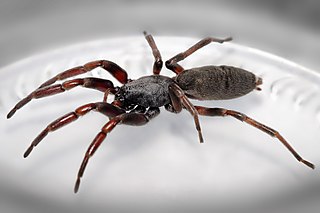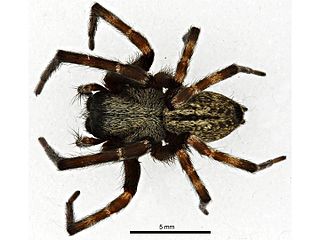
Wolf spiders are members of the family Lycosidae, from the Ancient Greek word "λύκος" meaning "wolf". They are robust and agile hunters with excellent eyesight. They live mostly in solitude and hunt alone, and do not spin webs. Some are opportunistic hunters pouncing upon prey as they find it or even chasing it over short distances. Some wait for passing prey in or near the mouth of a burrow.

Orb-weaver spiders are members of the spider family Araneidae. They are the most common group of builders of spiral wheel-shaped webs often found in gardens, fields and forest. "Orb" can in English mean "circular", hence the English name of the group. Araneids have eight similar eyes, hairy or spiny legs, and no stridulating organs.

The redback spider, also known as the Australian black widow, is a species of highly venomous spider believed to originate in South Australia or adjacent Western Australian deserts, but now found throughout Australia, Southeast Asia and New Zealand, with colonies elsewhere outside Australia. It is a member of the cosmopolitan genus Latrodectus, the widow spiders. The adult female is easily recognised by her spherical black body with a prominent red stripe on the upper side of her abdomen and an hourglass-shaped red/orange streak on the underside. Females usually have a body length of about 10 millimetres (0.4 in), while the male is much smaller, being only 3–4 mm (0.12–0.16 in) long.

The Australian garden orb weaver spider is a very common species of spider with many variants in size, shape, and colour across the coastal regions of Australia. They have very large abdomens when well-fed and exhibit a tremendous colour-range from off-white through tan, brown to almost black. They have a roughly leaf-shaped pattern on the top of their abdomen with a complex outline that is darker than the surrounding area. There may also be several whitish spots or one or more stripes. The spiders' cephalothoraxes (heads) and proximal leg segments are usually darker, mostly reddish or reddish brown. They are able to change their colour with each moult to better match the background upon which they rest during the day.

Eriophora is a genus of orb-weaver spiders first described by Eugène Simon in 1895. It occurs in the Americas, Australasia, and Africa. The name is derived from Ancient Greek roots, and means "wool bearing".

The katipō is an endangered species of spider native to New Zealand. It is one of many species in the genus Latrodectus, such as the Australian redback, and the North American black widow. The species is venomous to humans, capable of delivering a potentially dangerous bite. It is a small to medium-sized spider, with the female having a round black or brown pea-sized body. Red katipō females, found in the South Island and the lower half of the North Island, are always black, and their abdomen has a distinctive red stripe bordered in white. In black katipō females, found in the upper half of the North Island, this stripe is absent, pale, yellow, or replaced with cream-coloured blotches. These two forms were previously thought to be separate species. The male is much smaller than the female and quite different in appearance: white with black stripes and red diamond-shaped markings. Katipō are mainly found living in sand dunes close to the seashore. They are found throughout most of coastal New Zealand except the far south and west. Katipō feed mainly on ground dwelling insects, caught in an irregular tangled web spun amongst dune plants or other debris.

The spider genus Steatoda, in the family Theridiidae, includes about 120 recognized species, distributed around the world. One common name is cupboard spider, for many species build their webs in dark, sheltered, undisturbed places around the house or garden, in sheds and garages, under garden furniture, compost bins, and the like. Signs of the cupboard spider include small white spots of spider droppings, like small splashes of paint, on the floor underneath the web.

White-tailed spiders are spiders native to southern and eastern Australia, and so named because of the whitish tips at the end of their abdomens. The body size is up to 18 mm, with a leg-span of 28 mm. Common species are Lampona cylindrata and Lampona murina. Both these species have been introduced to New Zealand.

Steatoda grossa, commonly known as the cupboard spider, the dark comb-footed spider, the brown house spider, or the false widow, is a common species of spider in the genus Steatoda.

The black house spider or common black spider is a common species of cribellate Australian spider, introduced to New Zealand and Japan. A closely related species, Badumna longinqua, the grey house spider, has a similar distribution, but has also been introduced to the Americas.

Nicodamidae is a family of araneomorph spiders with about thirty species in seven genera. They are small to medium-sized spiders found near the ground of eucalypt forest in small sheet webs. The species of this family are only present in Australia and Papua New Guinea. In most cases the cephalothorax and legs are uniformly red and the abdomen black, for which these species are sometimes called the "red and black spider".

Porrhothele antipodiana, the black tunnelweb spider, is a spider found throughout much of New Zealand and the Chatham Islands in bush and gardens and is one of New Zealand's most researched spiders. It is related to tarantulas, and is a harmless relative of the venomous Australian funnel-web spider.

Steatoda capensis is a spider originating from South Africa. Its common names include the black cobweb spider, brown house spider, cupboard spider and due to its similarities to the katipō spider it is commonly known as the false katipō in New Zealand. Common throughout Southern Africa, it has been introduced into other countries and is now present in Australia and throughout New Zealand. It is a small spider, usually an all-over shiny black it may have a small bright red, orange, or yellow patch near the tip of the abdomen along with a crescent shaped band near the front of the abdomen.

Hexathele hochstetteri, commonly known as the banded tunnelweb spider, is a spider in the family Hexathelidae, found only in New Zealand. It is common on the North Island, and uncommon on the South Island.

Spiders are air-breathing arthropods that have eight legs, chelicerae with fangs generally able to inject venom, and spinnerets that extrude silk. They are the largest order of arachnids and rank seventh in total species diversity among all orders of organisms. Spiders are found worldwide on every continent except for Antarctica, and have become established in nearly every habitat with the exceptions of air and sea colonization. As of July 2019, at least 48,200 spider species, and 120 families have been recorded by taxonomists. However, there has been dissension within the scientific community as to how all these families should be classified, as evidenced by the over 20 different classifications that have been proposed since 1900.

Poecilopachys australasia, commonly known as the two-spined spider, is an Australian orb-weaving spider which has also been recorded in New Zealand since the early 1970s. The spider is nocturnal, spinning a cart-wheel-shaped web at night which it consumes in the morning. Females can be commonly found on the undersides of citrus tree leaves during the day.

Backobourkia is a genus of South Pacific orb-weaver spiders first described by Volker Framenau, Nadine Dupérré, Todd Blackledge & Cor Vink in 2010. It is a common Australian spider, closely related to Eriophora and placed in the "coxal hook clade" of the Araneinae subfamily of Araneidae. Females are generally the same size among all species, but males are much smaller, suggesting male dwarfism throughout the genus. The genus name is a play on the well known Australian idiom, "Back of Bourke", meaning very remote and beyond the limits of civilization.

Badumna longinqua or the grey house spider is a species of spiders in the family Desidae. Native to eastern Australia, it has been introduced into New Zealand, Japan, the United States, Mexico, and Uruguay.

Argyrodes antipodianus, also known as the dew drop spider, is a species of kleptoparasitic spider from the cobweb spider family found in Australia, New Zealand and New Caledonia.





















